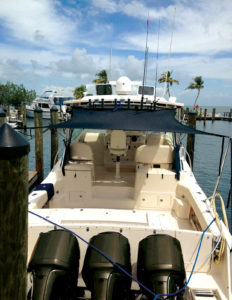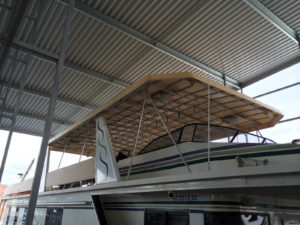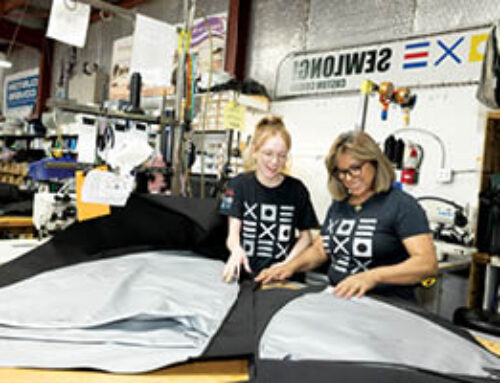Made in the shade
 An improved economy and concerns about solar exposure shine new light on sunshades.
An improved economy and concerns about solar exposure shine new light on sunshades.
By Pamela Mills-Senn
People are taking to the water in record numbers, encouraged in part by plummeting gas prices. According to the National Marine Manufacturers Association, approximately 89 million to 90 million Americans went boating in 2013 and 2014, respectively—the highest levels of participation ever recorded in recreational boating.
It seems as if the stars are aligning for the boating industry, and for marine fabricators as well. Last year’s sales activity nudged upward for many parts of the industry. Sales of traditional power boats revved up by 6 percent in 2014, as did sales of pre-owned boats. OEM boat manufacturers reported modest gains as well, noting a 2 to 3 percent boost in new boat sales. The U.S. and Canadian marine fabrics end-product market shared in the bounty, increasing by 7 percent to nearly 25 million square yards in 2014, according to the 2015 State of the Industry report (Part I) in the February 2015 issue of Specialty Fabrics Review, and is expected to grow 7–8 percent in 2015, reaching about 27 million square yards.
For marine fabricators—whether they supply custom, standard/kit, OEM or aftermarket solutions—two trends in particular are driving more business. First is the industry’s determination to put the fun back into boating through technology, offering an improved, more user-friendly experience, says Don Zirkelbach, president of Ameritex Fabric Systems, a member of the Taylor Made Group LLC. Headquartered in Bradenton, Fla., Ameritex is an OEM supplier of boat tops and enclosures.

Ameritex is an OEM supplier of custom fabrics for boats of all types and sizes, including a retractable fabric roof system for express cruisers. It opens and closes at the touch of a button. Photo: Ameritex Fabric Systems.
“Part of what is driving the resurgence in boating is the convenience factor,” he explains. “Manufacturers are introducing features and products that make boating easier and take the hassle out of it.”
Manufacturers are building boats with all manner of innovations, Zirkelbach says. Even the once-lowly pontoon boat has evolved. Today’s more sophisticated pontoons come with built-in wet bars, toilets and even entertainment centers, all of which encourage folks to stay on the water (or dockside) longer.
As boats become more value-added, there’s also a movement toward expanding the customer base by making boating more affordable and accessible, says Dana Russikoff, business leader and co-founder of SureShade. The Philadelphia, Pa.-based company designs and manufactures retractable factory-installed and aftermarket sunshade systems for the marine industry.
Russikoff says SureShade’s business has grown significantly over the past several years as the industry has begun to climb out from the recession. A second trend has also contributed to the company’s improved fortunes, and those of other marine fabricators: sun safety and boaters’ thirst for shade and shade structures. As people extend their time on the water, the demand for sunshade products is intensifying for both comfort and UV protection.

A Formula 45 yacht features a fully integrated SureShade ATF automated shade system. Photo: SureShade.
Changing perspectives
Nearly everyone now recognizes the need to limit sun exposure. Some may even have gone overboard on the subject. Katie Bradford, owner of Custom Marine Canvas in Noank, Conn., recalls overhearing a conversation between a husband and wife. “The woman wanted a shade structure added to the boat, but the husband was hesitant,” Bradford says. “She told him that without adding the structure, he was committing suicide and murder. He decided to add a shade structure.”
At this point, Bradford says, on anything other than a racing boat, almost every vessel has some sort of bimini top or shade structure. “Even power boats have them. And this is the test for us as fabricators—creating a product that can handle speed.”
Staying shaded is a fixation for boaters in his area, says Clint Halladay, assistant team leader and template maker for Sewlong–Custom Covers. Based in Salt Lake City, Utah, the company specializes in providing shade structures and enclosures for ski and runabout boats.
“With our altitude here in Utah, protection from the sun is the big selling point,” he says. “Our big destination lake in Utah is Lake Powell, and in the summer it’s not uncommon to get 100-plus-degree days for multiple days straight. So shade is very valuable.”

The new T-Top Boat Shade Kit is made with military-grade Resilience™ fabric, which provides superior elasticity and UV reflection properties. Photo: Taylor Made Products.
Sunshade structures not only enhance the boating experience, they protect the resale value of boats, because the majority of buyers now consider shade a necessity, adds Russikoff. New designs, new technologies and new control systems are making it an attractive market.
“Adding a retractable sunshade system is a noticeable upgrade to any boat, clearly differentiating it when it comes time to sell,” she explains. “Many boat dealers tell us they’re having a hard time selling new boat models that don’t have the shade.”
Challenges and solutions
When it comes to meeting the clamor for sunshades, marine fabricators must contend with a number of challenges, not the least of which is the vessels themselves.
“It’s very rare that a boat goes out without some sort of structure on it, like a T-Top, wakeboard tower or fishing rod holders,” says Dave Karpinski, vice president of sales and marketing for Taylor Made Products. Headquartered in Gloversville, N.Y., this is the aftermarket arm of the Taylor Made Group LLC, a supplier of aftermarket items including boat storage covers and bimini tops.
“At the same time, the demand for shade is increasing,” Karpinski adds. “In the past, shade would have been provided through a bimini top. But now the industry has evolved by using the existing structure of the boat and thinking out from this. The challenge for us as manufacturers is to come up with solutions.”

A new Folding Canopy Top from Custom Covers on a Centurion FS44 with a Maximus tower features custom-designed hardware with a strut and hinge build-in with spring-loaded pull pins to hold the strut in place when the top is open or closed. Photo: Custom Covers.
Consider T-Top boats. These offer limited shade, but extending the coverage shouldn’t interfere with functionality, Karpinski says. Since T-Tops are primarily used for fishing, it’s important that people are able to work in and around them. This year, Taylor Made Products introduced the T-Top Boat Shade Kit, an easy up-and-down, portable shade system that meets the need for sun protection and unimpeded movement.
The product incorporates a new, elastic-based fabric, Resilience™, initially designed by the military for desert use, says Karpinski. The highly breathable fabric, which stretches in both directions, offers a UV block of 98 percent and reflects up to 75 percent of UV heat.
One sunshade fabric application that Custom Marine Canvas is exploring is shade sails. Consisting of a mesh fabric, the tensioned shade sails are relatively new to the market. The fabric allows water to pass through it, allowing the flat, structural, fun shapes that are proving very popular. Bradford, who’s weighing the cost of incorporating the technology required to offer these against market demand, says she’s had a lot of inquiries about the product, which she’s starting to see on the mega-yachts.
Ski boats with towers pose issues requiring creative solutions, says Halladay. Existing canvas sunshades were either hard to use or didn’t offer enough coverage. Custom Covers responded by first introducing the Folding Trampoline Top (FTT), which evolved into the Folding Canopy Top (FCT).
“With manufacturers making their towers much wider, we’ve had to adjust,” Halladay says. “That has led us to our latest version of the FTC with all new mounting hardware and our own hinging system. Right now we’re only working on the Centurion Maximus Tower and the Nautique Flight Control G Series towers.”
Halladay adds that along with offering more coverage, ease of use has become an important consideration. Tops need to go up and down easily and quickly, and shouldn’t require much storage space—the reason that retractable sunshade systems have become so popular, says Russikoff.

Advancements in fabric technology, particularly the polyester-based materials that offer an enhanced strength-to-weight ratio, are allowing marine fabricators to offer larger covers and enclosures, expanding their market to bigger boats.
SureShade provides a variety of manual and automatic shade systems. The newest is the SureShade RTX™ pull-out shade, a lightweight, compact shade that incorporates the company’s telescoping framework but operates with a pull-out/push-in mechanism to extend or retract the canvas. The lower-cost shade product is a recommended solution for boats less than 27 feet with overhead tubular structures like towers on sports boats or soft-top framework on center consoles, says Russikoff.
Last year Ameritex unveiled a new canvas power retractable sunroof system that can operate in both power and manual modes and incorporates the company’s SureSeal™ technology. It’s designed with a top fabric section and inner liner that can be changed or replaced in minutes without fasteners (the outer top section and inner liner snap on using a mechanism similar to how a resealable plastic bag works). This enables consumers to easily replace a weathered outer piece, and to install different inner headliners to match the vessel’s décor.
In the works is a new class of extremely UV-stable custom shade products Ameritex plans to offer to boat builders, says Zirkelbach, noting that they’re continuing to see a need for more sunshade products offering protection for both the front and back of boats.
Growth from technology
TUUCI Inc. provides high-performance custom shade construction used in boating and in residential and commercial settings. Recently, the company began designing shade products that can cover entire large areas, such as an outdoor living room or over a dining table of 14 people or more, says Dougan Clarke, CEO and chief product architect for the company. Yachts can have a similar need for sizeable shade coverage. “The venues requiring shade span from upper deck pool and Jacuzzi® settings to the forward deck, open-air lounging terraces to applications that extend shade on massive dive platforms off the stern of mega yachts, creating both water-side lounging and dining ambiance,” says Clarke.
TUUCI recently launched the Shade Pod multiparasol concept, featuring a single, free-standing mast that can support up to four individual umbrellas and cover a 20-square-foot area. Although the product has not yet been deployed on a yacht, its use by that market is entirely possible.
SureShade is working on the next generation of its flagship SureShade ATF automated shade product, says Russikoff. Dubbed SureShade Silent Glide Technology (SGT), the product eliminates the actuator noise produced by the motors in the current ATF automated shade, the “single expressed market concern since its product launch,” says Russikoff. The SGT will be available to builders for the 2016 model year launch.
Product evolution has provided marine fabricators greater flexibility to be more innovative in the shade solutions they offer. Consider the AnchorShade® III, which blocks out 85–90 percent of harmful rays and is designed for use when the boat is anchored or at idle speed on a calm day. On the market for years, the first incarnation of this sun umbrella started out with an aluminum frame, says Karpinski. Now, with the AnchorShade III, the structure has been converted to fiberglass, with larger-diameter fiberglass ribs and nylon connectors, offering improved resistance against the elements and greater flexibility.
Advancements in fabric technology, particularly the polyester-based materials that offer an enhanced strength-to-weight ratio, are allowing marine fabricators to offer larger covers and enclosures, expanding their market to bigger boats, says Karpinski.
The Internet is also opening up new opportunities. Bradford says she started using high-performance WeatherMAX® fabric after a customer saw it online and asked about it. Through their respective websites, Taylor Made Products and Ameritex enable customers and their marine retail partners to order replacement products. Ameritex also inserts QR labels into specific canvas products. Consumers or boat builders can scan the label with a smartphone or iPad to access an instructional video on how to install the product, care for it or store it, says Zirkelbach. It’s become so popular they’re adding more QR labels and producing more videos.
Shade products, on and off the water, continue to be a growth area. Marine fabrication requires a special set of skills and tools, but as fabrics and frame technologies evolve, more options will be available to an increasingly knowledgeable public. Marine fabricators may find themselves in partnership with architects and developers to shade lavish dockside entertainment areas … margaritas optional.
Pamela Mills-Senn is a freelance writer living in Long Beach, Calif.
 TEXTILES.ORG
TEXTILES.ORG 






